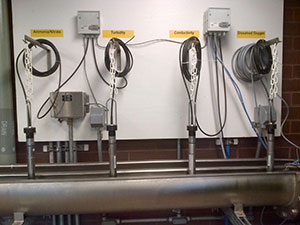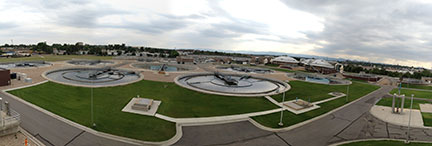Wastewater Process Monitoring & Control to Increase Productivity and Efficiency
The Littleton/Englewood wastewater treatment plant, Colorado, put in place processes to effectively monitor the levels of ammonia in their wastewater treatment. As well as ammonia levels, the plant is now able to effectively conduct pre-chlorination monitoring, monitoring of dissolved air flotation thickeners, and the measurement of dissolved oxygen concentration.
Accurate measurement of these parameters is imperative to ensure an efficient process in both time and cost.
Wastewater Treatment
 The need for efficient wastewater treatment technologies is becoming progressively more important. Ever-increasing population, urbanization, and industrialization along with a reduction in personnel and pressure to save energy costs are putting a lot of pressure on municipalities to do more with less.
The need for efficient wastewater treatment technologies is becoming progressively more important. Ever-increasing population, urbanization, and industrialization along with a reduction in personnel and pressure to save energy costs are putting a lot of pressure on municipalities to do more with less.
For these reasons, many treatment plants are required to adhere to strict regulations regarding their wastewater effluent. The effective monitoring of various applications including ammonia is vital to the wastewater industry and is essential to ensure that wastewater treatment plants are able to operate efficiently while protecting the surrounding environment.
Ammonia is a wide cause of concern as it can cause severe problems in the disinfection process and in extreme cases can cause drinking water to become hazardous. Ammonia is also fatal to fish and other aquatic life when it is changed to unionized ammonia gas with increased river temperatures.
In 1994, ammonia limits were initiated by the Colorado Department of Public Health and Environment (CDPHE). The CDPHE specifies an individual monthly average and daily limit that treatment plants must adhere to. Wastewater treatment plants must therefore keep their discharge within these limits in order to meet their permit and avoid potential fines. Continuous, real-time ammonia monitoring can be complex and costly, therefore a smart solution is needed to make the process simpler, as well as more cost-effective.
Effective Continuous Monitoring
Founded in 1977 as a pure oxygen activated sludge plant, the Littleton/Englewood wastewater treatment plant is the third-largest publicly owned treatment works in the state of Colorado. The plant receives sewage from Littleton and Englewood, as well as 21 smaller districts in the service area.
In 2009 a $110 million construction project was completed which transformed the plant into a fifty million gallons per day (mgd) trickle filter/ solids contact facility with post nitrification and post denitrification capabilities. The large advanced treatment plant is required to exceed secondary treatment requirements and remove ammonia from wastewater, working in compliance with local, state, and federal regulations applicable to wastewater treatment and discharge.
Water from the treatment plant discharges into the South Platte River, a river widely used for recreational purposes and drinking water, as well as supporting various ecosystems in surrounding areas.
The river is classified as a Class 1 Recreation Scheme and contains many species of fish, including trout. Due to the danger, it can cause, the continuous monitoring of ammonia levels is vital. In addition to this, the plant also required solutions for a number of other applications including pre-chlorination monitoring, monitoring of dissolved air flotation thickeners, and the measurement of dissolved oxygen concentration.
Multiparameter Water Quality Solution
In order to ensure accurate measurement of these parameters, the Littleton/Englewood plant set up a procedure to find the new instrumentation it needed to meet multiple requirements. Greg Farmer, process control administrator in the plant’s operations department, explains;
“The dissolved oxygen models used previously were becoming increasingly outdated and were no longer suitable for use in controlling dissolved oxygen levels in the aeration basins.”
Various products were assessed for their suitability for monitoring oxygen levels while increasing productivity, with each type was tested side by side.
The YSI IQ SensorNet 2020 3G system provided the most accurate results and involved the least amount of operator oversight. The system allows the plant to customize its analytical measurements and enables the facility to incorporate any combination of up to 20 sensors into one sensor network which communicates directly with the plant’s internal computerized control system.
The plant now utilizes a system-wide solution to manage its multiple sensor networks allowing the facility to ‘keep on growing’, adding more sensors as and when needed. Implementation of the system at the facility has enabled the plant to undertake a wide variety of different applications using a single system, offering highly economical operation, and providing maximum total cost of ownership.

Applications
As a result of the plant’s investment in new technology, it can now utilize one system for multiple needs, including the following.
Centrate Return Ammonia
By continuously measuring the amount of ammonia in the aeration basin, the team is able to monitor the contribution of ammonia from the return of anaerobic sludge dewatering centrate to the aeration basin. An ammonia concentration target is entered into the SCADA system and the centrate pump output is varied to attain the desired concentration in the aeration basin. By monitoring and controlling the amount of ammonia present, the ammonia loading to the nitrification process is kept within target ranges, which improves efficiency in the conversion of ammonia into nitrate.
Pre-Chlorination Disinfection
One of the most important advantages of the IQ SensorNet for the plant is the benefits that arise during disinfection. Chlorination of wastewater provides the disinfection necessary to protect the receiving stream and downstream users. Greg explains, “A certain ratio of ammonia to chlorine must be maintained for this process to work most efficiently.” The ammonia concentration prior to disinfection is monitored using the selected sensor, with the value being fed into the SCADA system and compared to the desired ammonia concentration setpoint.
The collated information is used to vary the output of pumps that can bypass a flow of ammonia rich secondary effluent around the nitrification process, thereby maintaining the desired ammonia setpoint and maintaining the critical ammonia to chlorine ratio. The technology ensures that the chlorination process works and guarantees that the plant achieves very low fecal coliform levels while also keeping ammonia levels at a minimum.
Dissolved Air Flotation Thickeners
Prior to introducing new instrumentation, the plant used a constant dosage of polymer to keep the subnatant suspended solids at an acceptable level when thickening waste activated sludge (WAS) and primary sludge in dissolved air flotation thickeners. This resulted in periods of under dosage both when suspended solids were higher than desired and when the polymer was being wasted. The suspended solids in the subnatant are returned to the treatment process adding to the loading on those processes.
Therefore it is vital to use a reliable online measuring instrument to ensure an efficient and energy-saving control of the process. The subnatant suspended solids are measured and the values are fed into the SCADA system. The values are compared to the setpoint and polymer adjustments are made.
Key Benefits
The versatility of the multi-sensor IQ SensorNet 2020 3G allows Littleton/Englewood to solve several problems using a single system, contributing not only significant cost savings but also enabling multiple probes to be used in a variety of locations throughout the plant. The facility has also been able to automate sections of its treatment procedures based on the information that has been collated by the system, significantly accelerating processes. Due to the location’s weather conditions, the plant was previously unable to use probes that required water to be pumped from an outdoor location to an indoor analyzer as it was highly likely it would freeze in the winter. The IQ SensorNet does not have this problem and the plant can continue to function outside in freezing conditions.
Smart Solution
Successful monitoring of various applications by wastewater treatment plants is now a necessity. Continuous and accurate monitoring ensures that wastewater treatment plants remain safe for humans and the environment as well as staying within the specified legal regulations. This meant that the Littleton/Englewood wastewater plant needed a system that would allow it to accurately measure multiple parameters and meet the ammonia limitations that were put in place in 1994 by the CDPHE.
Prior to their use of the IQ SensorNet, the plant used equipment that required a lot of personnel hours to ensure its correct running and operation. Since the introduction of the new technology, the plant has benefited from the instruments working with less assistance from staff once installed. Whereas data used to be manually retrieved from the field, it is now automated with the continuous monitoring and control of the IQ SensorNet. The information that is collected from the various probes can then be analyzed for trends and patterns. This can be used to learn more about the finer details of the operation and further increase long-term productivity and efficiency.
Additional Blog Posts of Interest:
Wastewater Process Control - Which Strategy is Right for You?
Shortcut the Nitrogen Removal Process in Wastewater with UV Sensors
Wastewater Aeration Control - Energy Cost Savings Examples
Myths and Realities: Ammonium Based Aeration Control in Wastewater